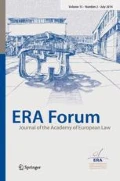Abstract
This article considers two topics that are directly related to digital evidence: (i) encrypted data and (ii) software, logic and proof: understanding more than the output of electronic evidence. Both topics are of significance in legal proceedings, especially criminal proceedings. In relation to encrypted data, this article briefly considers how such data is treated in Canada, England & Wales and the United States of America. Respecting the topic of software, logic and proof: understanding more than the output of electronic evidence, the aim is to illustrate why it is necessary to understand the nature of the technology and why it is necessary to enquire into causation in respect of evidence in digital format.
Similar content being viewed by others
Notes
2007 WL 4246473 (D.Vt.).
In re Grand Jury Subpoena to Sebastien Boucher, 2009 WL 424718 (D.Vt.).
The Boucher case was not cited in an identical argument before Borman, DJ in United States of America v. Kirschner, 2010 WL 1257355 (E.D. Mich.), who decided that the subpoena requiring the defendant to give up the password must be quashed, on the basis that the request would incriminate him. For more discussion and reference to other articles, see Colarusso [1]; Fakhoury [2]; for the position in Slovenia, see Šepec [6].
2008 CANLII 27481 (ON SC).
[2008] WLR (D) 313, [2008] EWCA Crim 2177.
[2008] EWCA Crim 2177, [2008] WLR (D) 313 at 21.
2007 WL 4246473 (D. Vermont Nov. 29, 2007).
In the 2008–2009 Annual Report by the Chief Commissioner of the Office of Surveillance Commissioners, The Rt. Hon. Sir Christopher Rose indicated at 4.11 that ‘During the period of this report, NTAC approved 26 applications for the service of a notice under s.49 of RIPA Part III. Of these 17 went on to obtain permission from a Judge. No permissions were refused and 15 Notices were served. Eleven individuals failed to comply resulting in seven charges and two convictions. The types of crime under investigation were: counter terrorism, child indecency and domestic extremism.’
United States Court of Appeals for the Eleventh Circuit No 00-14592 July 17, 2002 before Anderson and Marcus, Circuit Judges, and Middlebrooks, District Judge available in electronic format at http://laws.lp.findlaw.com/11th/0014592opn.html.
For a more detailed discussion, see Mason [3], 4.01; 10.66–10.82.
Willassen [7], 210.
KL HC Com. Div. D-22NCC439-2011, discussed in detail in Radhakrishna [5].
United States District Court for the District of Columbia No 00-2325 (ESH) 26 March 2003.
State of Connecticut v Julie Amero (Docket number CR-04-93292; Superior Court, New London Judicial District at Norwich, GA 21; 3, 4 and 5 January 2007); for a detailed analysis of this case, see Mason [4], xxxvi–lxxv.
(1983) 76 Cr App R 23, [1982] Crim LR 667, CA.
(1979) 21 S.A.S.R. 569.
[1980] 2 NZLR 124.
(1993) 70 A Crim R 133; also cited as Rook v Maynard (1993) 126 ALR 150.
[2009] EWCA Civ 46.
[2009] EWCA Civ 46 at 5.
[2009] EWCA Civ 46 at 21.
[2009] EWCA Civ 46 at 51.
The Crypto Law Survey is maintained by Professor Bert-Jaap Koops: http://cryptolaw.org.
References
Colarusso, D.: Heads in the clouds, a coming storm—the interplay of cloud computing, encryption, and the fifth amendment’s protection against self-incrimination. Boston Univ. School Law J. Sci. Technol. Law 17(1) (2011)
Fakhoury, H.: A combination or a key? The fifth amendment and privilege against compelled decryption. Dig. Evid. Electron. Signat. Law Rev. 9, 81–87 (2012)
Mason, S. (gen. ed.): Electronic Evidence, 3rd edn. LexisNexis Butterworths, London (2012)
Mason, S. (gen. ed.): International Electronic Evidence. British Institute of International and Comparative Law, London (2008)
Radhakrishna, G.: E-mail evidence and the hearsay rule—commentary on a recent Malaysian case. Dig. Evid. Electron. Signat. Law Rev. 10, 107–114 (2013)
Šepec, M.: Digital data encryption—aspects of criminal law and dilemmas in Slovenia. Dig. Evid. Electron. Signat. Law Rev. 10, 147–154 (2013)
Willassen, S.Y.: Line based hash analysis of source code infringement. Dig. Evid. Electron. Signat. Law Rev. 6, 210–213 (2009)
Author information
Authors and Affiliations
Corresponding author
Rights and permissions
About this article
Cite this article
Mason, S. Electronic evidence: dealing with encrypted data and understanding software, logic and proof. ERA Forum 15, 25–36 (2014). https://doi.org/10.1007/s12027-013-0332-x
Published:
Issue Date:
DOI: https://doi.org/10.1007/s12027-013-0332-x




